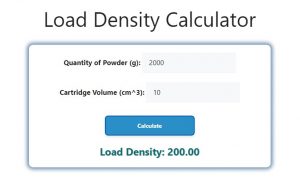About Load Density Calculator (Formula)
The Load Density Calculator is a vital tool for engineers, architects, and anyone involved in logistics and material handling. Load density refers to the weight of a load relative to its volume, providing insights into how materials are distributed in a given space. This measurement is crucial for various applications, including shipping, construction, and safety assessments. By accurately calculating load density, professionals can optimize storage solutions, ensure structural integrity, and improve overall efficiency in material handling.
Formula
The formula to calculate load density is:
Load Density equals Load Weight divided by Load Volume.
Where:
- Load Weight is the total weight of the load, usually measured in kilograms or pounds.
- Load Volume is the total volume occupied by the load, typically measured in cubic meters or cubic feet.
How to Use
- Collect Necessary Data: Measure the load weight and load volume using appropriate tools.
- Input Values into the Formula: Substitute the measured values into the load density formula.
- Perform the Calculation: Calculate the load density by dividing the load weight by the load volume.
- Analyze the Result: Use the calculated load density to inform decisions about storage, transport, and structural considerations.
Example
Imagine you have a shipping container with the following details:
- Load Weight: 2000 kg
- Load Volume: 10 m³
Using the formula:
Load Density = 2000 kg / 10 m³
Calculating this gives:
Load Density = 200 kg/m³
This means the load density of the container is 200 kg/m³, which can be used to assess the suitability of the container for transport and storage.

FAQs
1. What is load density?
Load density is the weight of a load per unit of volume, indicating how much mass is concentrated in a specific space.
2. Why is load density important?
It helps assess weight distribution for safety, efficiency, and compliance with transportation regulations.
3. How do I measure load weight?
Load weight can be measured using scales, load cells, or similar devices.
4. How is load volume determined?
Load volume is calculated based on the dimensions of the load, using the formula length × width × height.
5. What units are used for load density?
Load density is typically expressed in kilograms per cubic meter (kg/m³) or pounds per cubic foot (lb/ft³).
6. Can load density affect shipping costs?
Yes, higher load densities can lead to more efficient transport, potentially reducing shipping costs.
7. What is the maximum load density for shipping containers?
It varies by container type and regulations, but typically ranges from 1,000 kg/m³ to 1,300 kg/m³ for general cargo.
8. How does load density impact structural integrity?
Higher load densities can increase stress on structures, requiring careful consideration in design and material selection.
9. Is load density the same as weight density?
No, weight density refers specifically to the weight of a material per unit volume, whereas load density considers the total weight of a load.
10. How can I reduce load density?
You can reduce load density by using lighter materials, optimizing the load distribution, or increasing the volume of the load.
11. How often should I calculate load density?
Calculate load density whenever there are changes in the load’s weight or volume to ensure safety and compliance.
12. Can load density change over time?
Yes, load density can change due to factors like moisture absorption or compaction.
13. What is a typical load density for construction materials?
Construction materials like concrete typically have a load density of around 2,400 kg/m³.
14. How does temperature affect load density?
Temperature changes can affect the weight of some materials (e.g., expansion or contraction) but typically do not impact volume.
15. Can load density be used for liquids?
Yes, load density is applicable to liquids, calculated as the weight of the liquid per unit volume.
16. How do I find load density for irregularly shaped objects?
For irregular shapes, water displacement methods can be used to find volume, then calculate load density.
17. What factors can affect load density calculations?
Factors include material moisture content, compaction level, and temperature.
18. Are there calculators available for load density?
Yes, many online calculators can assist in quickly calculating load density.
19. Can I use this calculator for bulk materials?
Absolutely, the load density calculator is useful for bulk materials in storage and transport.
20. How do I know if my load density is safe?
Compare your calculated load density to industry standards and guidelines to assess safety.
Conclusion
The Load Density Calculator is an essential tool for accurately measuring and understanding load distribution in various applications. By utilizing this calculator, professionals can ensure safe transport and storage, optimize material handling processes, and maintain structural integrity in their projects. Whether in logistics, construction, or manufacturing, understanding and calculating load density is key to efficient operations and compliance with safety standards.
